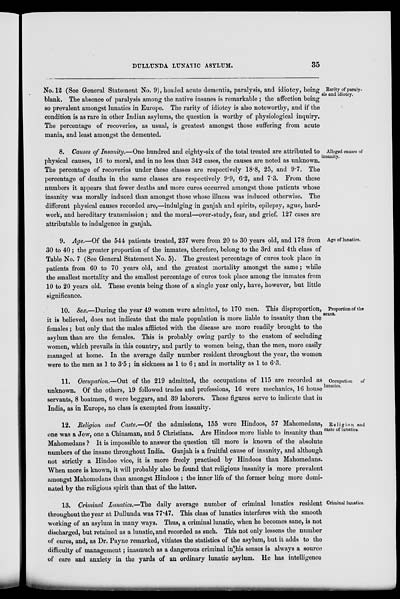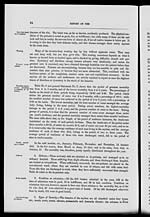Medicine - Mental health > 1867-1924 - Annual report of the insane asylums in Bengal > Insane asylums in Bengal annual reports 1867-1875 > Annual report on the insane asylums in Bengal for the year 1872
(547) Page 35
Download files
Individual page:
Thumbnail gallery: Grid view | List view

DULLUNDA LUNATIC ASYLUM. 35
Rarity of paraly-
sis and idiotcy.
No. 12 (See General Statement No. 9), headed acute dementia, paralysis, and idiotcy, being
blank. The absence of paralysis among the native insanes is remarkable ; the affection being
so prevalent amongst lunatics in Europe. The rarity of idiotcy is also noteworthy, and if the
condition is as rare in other Indian asylums, the question is worthy of physiological inquiry.
The percentage of recoveries, as usual, is greatest amongst those suffering from acute
mania, and least amongst the demented.
Alleged causes of
insanity.
8. Causes of Insanity.—One hundred and eighty-six of the total treated are attributed to
physical causes, 16 to moral, and in no less than 342 cases, the causes are noted as unknown.
The percentage of recoveries under these classes are respectively 18.8, 25, and 9.7. The
percentage of deaths in the same classes are respectively 9.9, 6.2, and 7.3. From these
numbers it appears that fewer deaths and more cures occurred amongst those patients whose
insanity was morally induced than amongst those whose illness was induced otherwise. The
different physical causes recorded are,—indulging in ganjah and spirits, epilepsy, ague, hard-
work, and hereditary transmission; and the moral—over-study, fear, and grief. 127 cases are
attributable to indulgence in ganjah.
Age of lunatics.
9. Age.—Of the 544 patients treated, 237 were from 20 to 30 years old, and 178 from
30 to 40 ; the greater proportion of the inmates, therefore, belong to the 3rd and 4th class of
Table No. 7 (See General Statement No. 5). The greatest percentage of cures took place in
patients from 60 to 70 years old, and the greatest mortality amongst the same; while
the smallest mortality and the smallest percentage of cures took place among the inmates from
10 to 20 years old. These events being those of a single year only, have, however, but little
significance.
Proportion of the
sexes.
10. Sex.—During the year 49 women were admitted, to 170 men. This disproportion,
it is believed, does not indicate that the male population is more liable to insanity than the
females; but only that the males afflicted with the disease are more readily brought to the
asylum than are the females. This is probably owing partly to the custom of secluding
women, which prevails in this country, and partly to women being, than the men, more easily
managed at home. In the average daily number resident throughout the year, the women
were to the men as 1 to 3.5 ; in sickness as 1 to 6; and in mortality as 1 to 6.3.
Occupation of
lunatics.
11. Occupation.—Out of the 219 admitted, the occupations of 115 are recorded as
unknown. Of the others, 19 followed trades and professions, 16 were mechanics, 16 house
servants, 8 boatmen, 6 were beggars, and 39 laborers. These figures serve to indicate that in
India, as in Europe, no class is exempted from insanity.
Religion and
caste of lunatics.
12. Religion and Caste.—Of the admissions, 155 were Hindoos, 57 Mahomedans,
one was a Jew, one a Chinaman, and 5 Christians. Are Hindoos more liable to insanity than
Mahomedans ? It is impossible to answer the question till more is known of the absolute
numbers of the insane throughout India. Ganjah is a fruitful cause of insanity, and although
not strictly a Hindoo vice, it is more freely practised by Hindoos than Mahomedans.
When more is known, it will probably also be found that religious insanity is more prevalent
amongst Mahomedans than amongst Hindoos ; the inner life of the former being more domi-
nated by the religious spirit than that of the latter.
Criminal lunatics.
13. Criminal Lunatics.—The daily average number of criminal lunatics resident
throughout the year at Dullunda was 77.47. This class of lunatics interferes with the smooth
working of an asylum in many ways. Thus, a criminal lunatic, when he becomes sane, is not
discharged, but retained as a lunatic, and recorded as such. This not only lessens the number
of cures, and, as Dr. Payne remarked, vitiates the statistics of the asylum, but it adds to the
difficulty of management; inasmuch as a dangerous criminal in his senses is always a source
of care and anxiety in the yards of an ordinary lunatic asylum. He has intelligence
Set display mode to: Large image | Zoom image | Transcription
Images and transcriptions on this page, including medium image downloads, may be used under the Creative Commons Attribution 4.0 International Licence unless otherwise stated. ![]()
| Permanent URL | https://digital.nls.uk/83379641 |
|---|




